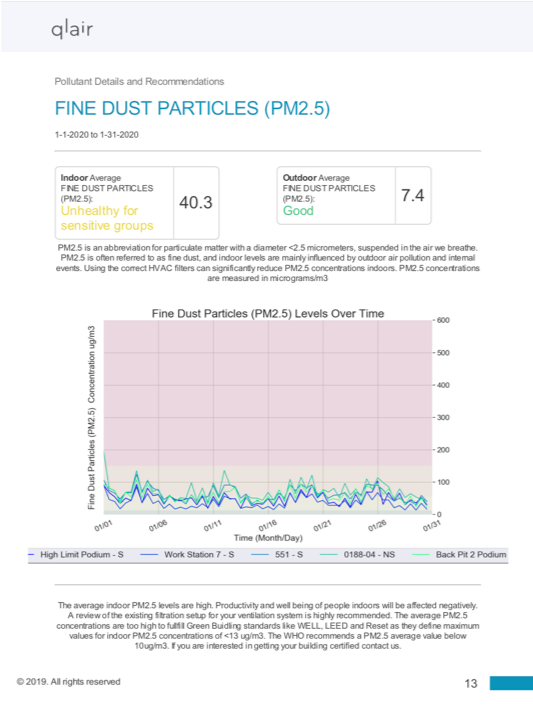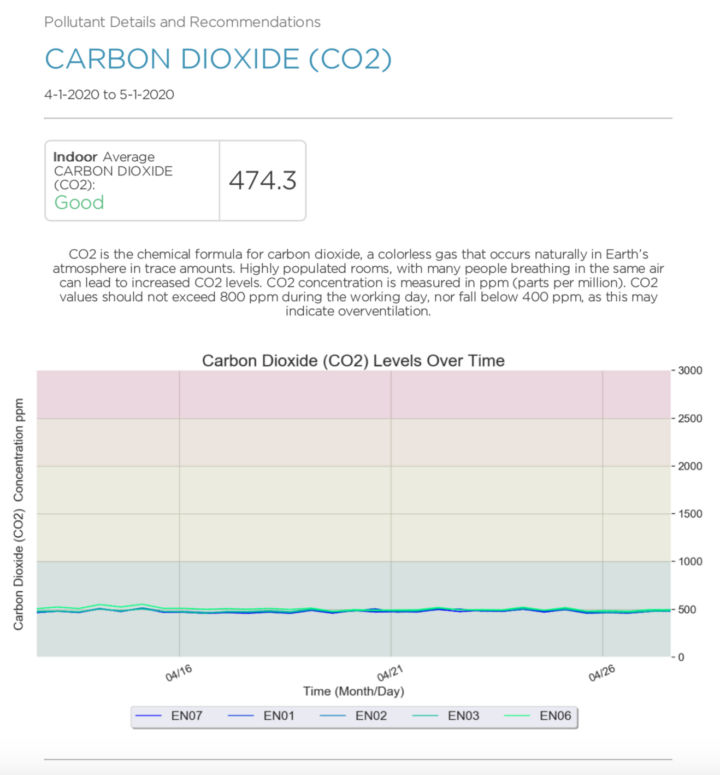The US Environmental Protection Agency (EPA) and the Association for Heating, Refrigeration and Air-Condition Engineers (ASHRAE) are two industry experts that provide trusted indoor air quality standards for building construction and management. We compiled their recommendations with peer-reviewed research to provide a list of the important indoor air quality standards to consider prior to reopening your office building. qlair’s intelligent indoor air quality solutions allow your building to meet building these building guidelines and so much more.
The Air Quality Index: EPA Standards
The US Air Quality Index (AQI) is the EPA’s index for reporting air quality and can be helpful for maintaining indoor air quality standards. The index spans from 0 to 500 and the higher the AQI value, the greater the level of air pollution and the greater the health concern. Satisfactory air quality is reached at 50 and below, while air quality becomes unhealthy for sensitive groups after 100. Accompanying the range for each level of concern, you will find a description of the air quality and concerns to consider.

ASHRAE Indoor Air Quality Guidelines: During and After COVID-19
ASHRAE contends that SARS-CoV-2 transmission through the air is sufficiently likely, and changes to building operations, including the operation of heating, ventilating, and air-conditioning systems, can reduce airborne exposures. In addition to activities like increasing your ventilation rates and increasing your filtration efficiency, proper indoor air quality management is recommended.
Ventilation and filtration provided by heating, ventilating, and air-conditioning systems can reduce the airborne concentration of SARS-CoV-2 and thus the risk of transmission through the air. Unconditioned spaces can cause thermal stress to people that may be directly life threatening and that may also lower resistance to infection.
Critical Indoor Air Quality Standards for Office Buildings
Relative Humidity
COVID-19 is a lipid-enveloped respiratory virus, like influenza and respiratory syncytial virus. These viruses tend to survive longer at a lower relative humidity, typically under 30 percent. To reduce the airborne concentration of COVID-19 keeping your relative humidity between 40 and 70 percent is recommended, as there is a minimal survival rate for both lipid-enveloped and nonlipid-enveloped viruses.

How to make sure your humidity stays at the correct level.
With qlair’s continuous indoor air quality monitoring, we monitor humidity levels in real time. Our in-depth monthly reports provide data on your air quality and provide alerts when there are critical activities occurring. For example, if your humidity level was to surpass 60 percent, you would be notified of potential mold and virus transmission risk.
Particulate Matter
Particulate Matter (PM), also known simply as fine dust, appears predominantly in two sizes: 2.5 micron (PM2.5) and 10 micron (PM10). Of the two, PM2.5 can pose a much greater risk to human health, as the particles are very small and can be inhaled deep into the lungs. You will want to make sure the airborne concentration PM2.5 is kept between 0 and 10 ug/m3 to ensure the health and safety of your indoor environment. Harvard research shows that a small increase in long-term exposure to PM2.5 can increase COVID-19 mortality rates significantly.2
How to keep particulate matter levels below 10 ug/m3.
First, it is important to figure out what your PM levels are at currently, so you can see if you need to make any adjustments to ensure proper air quality. Start by installing qlair’s indoor air quality monitors, identifying any critical areas in your facility.
If particulate levels are too high, you may need to increase the efficiency of your filtration. Selecting a higher MERV rating will allow you to capture finer particulates that fill the ambient air.
For special cases, or spaces without central ventilation, you may need to introduce an air purifying machine like the Tri-Kleen 500 UV from i2m. After installing your machine, you can see pollutant levels drop as the machine runs, cleaning the contaminated air.

Carbon Dioxide
Although Carbon Dioxide (CO2) may not have a direct implication on the spread of COVID-19, high concentrations of CO2 can be an indication of poor ventilation rates. During a time when the indoor environment should be pumped with as much fresh air as possible, it is important to ensure all spaces are receiving proper ventilation. By identifying areas with high CO2 concentrations, you may be able to find areas that are too-heavily occupied, or that are not receiving proper air flow for some reason.
How to ensure proper ventilation throughout your building.
qlair’s indoor air quality solutions provide you with comprehensive visibility into your building’s air quality. By tracking down areas with high levels of Carbon Dioxide, you can conduct inspections in the area to identify occupancy rates, filtration efficiency, etc. In some cases, portable negative machines may be used to aid in the purification of your indoor air.

Getting Started with Safe, Clean Indoor Air
Qlair is helping buildings provide clean, safe air to their occupants. We have partnered with a leader in facility cleaning and disinfecting – Spiffy – to provide a holistic approach for safe, clean, and intelligent workplace reopening.

